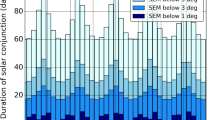Abstract
We have considered possible architecture options for an interplanetary communication system in which a data relay is used. The structure of a typical space communication link and the ways to improve its efficiency are analyzed. As one possibility, it is proposed to use accompanying orbital data-relay satellites providing the required data-transmission rate in the mode of formation flight together with the research spacecraft (SC). The optimization of the heliocentric leg of the flight trajectory of the Martian research SC and its accompanying data-relay satellite was carried out. The principal possibility of providing a formation flight of the data-relay satellite and research SC to improve communication with the Earth is demonstrated. Estimates were obtained for the masses of data-relay satellite and research SC with regard to the use of medium-lift launch vehicle of Soyuz type and a Fregat booster. Estimates are given for an increase in the duration of high-speed communication due to the use of a data-relay satellite in libration points L4 and L5 of the Earth–Sun system, as well as in heliocentric circular orbits with different radii.





Similar content being viewed by others
REFERENCES
Stampfl, R.A. and Jones, A.E., Tracking and data relay satellites, IEEE Trans. Aerosp. Electron. Syst., 1970, vol. AES-6, no. 3, pp. 276–289.
Toral, M., Heckler, G., Pogorelc, P., et al., Payload performance of third generation TDRS and future services, Proc. 35th AIAA Int. Commun. Satell. Syst. Conf. ICSSC, 2017, p. AIAA 2017–5433. https://doi.org/10.2514/6.2017-5433
Witting, M., Hauschildt, H., Murrell, A., et al., Status of the European data relay satellite system, Proc. Int. Conf. Space Opt. Syst. Appl. (ICSOS), Ajaccio, France, 2012, pp. 19–30.
Hunter, J., The orbiting deep space relay station—a study report, Proc. AIAA Conf. Large Space Platforms: Future Needs Capabilities, Los Angeles, USA, 1978, p. 1639.
Wilson, K.E., Wright, M., Cesarone, R., et al., Cost and performance comparison of an Earth-orbiting optical communication relay transceiver and a ground-based optical receiver subnet, IPN Progress Rep. 42–153, 2003.
Cornwell, D.M., NASA’s optical communications program for 2017 and beyond, Proc. IEEE Int. Conf. Space Opt. Syst. Appl., 2017, pp. 10–14. https://doi.org/10.1109/ICSOS.2017.8357203
Cerf, V., Burleigh, S., Hooke, A., et al., Interplanetary Internet (IPN): Architectural Definition, 2001. https:// datatracker.ietf.org/doc/html/draft-irtf-ipnrg-arch-00.txt.
Travis, E., The InterPlaNetary Internet: Architecture and key technical concepts, Internet Global Summit, INET, 2001.
Bhasin, K. and Hayden, J., Space internet architectures and technologies for NASA enterprises, IEEE Aerospace Conference, USA, 2001, vol. 2, pp. 931–941.
Domingo, V., Fleck, B., and Poland, A.I., The SOHO mission: An overview, Sol. Phys., 1995, vol. 162, pp. 1–37.
Bennett, C.L., Larson, D., Weiland, J.L., et al., Nine-year Wilkinson Microwave Anisotropy Probe (WMAP) observations: Final maps and results, Astrophys. J. Suppl. Ser., 2013, vol. 208, no. 2. https://doi.org/10.1088/0067-0049/208/2/20
Wilson, L.B., Brosius, A.L., Gopalswamy, N., et al., A quarter century of WIND spacecraft discoveries, Rev. Geophys., 2021, vol. 59, no. 2. https://doi.org/10.1029/2020RG000714
Howard, T.G., An initial design assessment for a communications relay satellite to support the interplanetary information infrastructure, 16th AIAA International Communications Satellite Systems Conference, 1996, pp. 566–575. https://doi.org/10.2514/6.1996-1057
Haque, S., A broadband multi-hop network for Earth–Mars communication using multi-purpose interplanetary relay satellites and linear-circular commutating chain topology, 49th AIAA Aerospace Sciences Meeting including the New Horizons Forum and Aerospace Exposition, 2011. https://doi.org/10.2514/6.2011-330
Wan, P. and Zhan, Y., A structured Solar System satellite relay constellation network topology design for Earth–Mars deep space communications, Int. J. Satell. Commun. Network, 2019, vol. 37, no. 3, pp. 292–313. https://doi.org/10.1002/sat.1287
Bhasin, K., Hayden, J.L., and Scott Sands, O., Relay station based architectures and technology for space missions to the outer planets, 20th AIAA International Communication Satellite Systems Conference and Exhibit, 2002. https://doi.org/10.2514/6.2002-2066
Vargauzin, V.A. and Tsikin, I.A., Metody povysheniya energeticheskoi i spektral’noi effektivnosti tsifrovoi radiosvyazi (Methods for Improving the Energy and Spectral Efficiency of Digital Radio Communications), St. Petersburg: BKhV-Peterburg, 2013. ISBN 978-5-9775-0878-0.
Modenini, D., Locarini, A., Valentini, L., et al., Two-leg deep-space relay architectures: Performance, challenges, and perspectives, IEEE Transactions on Aerospace and Electronic Systems, 2022, vol. 58, no. 5. https://doi.org/10.1109/TAES.2022.3178663
Jiang, Y., Li, G., Zhang, G., et al., The hierarchical-cluster topology control strategy of interplanetary internet backbone based on libration points, Przegląd Elektrotechniczny (Electrical Review), 2012, vol. 88, no. 4. ISSN 0033-2097.
Pit’eva et al., Ephemerides EPM2008. ftp://quasar.ipa. nw.ru/incoming/EPM/EPM2008.
Anshakov, G.P., Kapitonov, V.A., Kirilin, A.N., et al., Launch vehicle Rus’—new features of the famous “seven,” Polet, 2006, no. 3, pp. 3–8.
Asyushkin, V.A., Vikulenkov, V.P., Ishin, S.V., et al., Universal booster block of increased power-to-weight ratio Fregat-SBU, Vestn. NPO im. S.A. Lavochkina, 2017, no. 2, pp. 147–156.
Asyushkin, V.A., Vikulenkov, V.P., Ishin, S.V., et al., Improved Fregat-type upper stage for advanced medium-class space rockets, Vestn. NPO im. S.A. Lavochkina, 2018, no. 2, pp. 3–12.
Manzella, D., Sarmiento, Ch., Sankovic, J., et al., Performance evaluation of the SPT-140, 25th International Electric Propulsion Conference sponsored by the Electric Rocket Propulsion Society, Cleveland, Ohio, USA, 1997. NASA TM–97-206301. IEPC–97–059. https://ntrs.nasa.gov/api/citations/19980016322/downloads/19980016322.pdf.
Konstantinov, M.S., Petukhov, V.G., and Thein, M., Optimizatsiya trayektorii geliotsentricheskikh pereletov (Optimization of Heliocentric Transfer Trajectories), Moscow: Mosk. Aviats. Inst., 2015.
Fedotov, G.G., Possibilities of combining high- and low-thrust engines in flights to Mars, Cosmic Res., 2001, vol. 39, no. 6, pp. 574–582.
Fedotov, G.G., Optimization of flights between the orbits of artificial satellites of two planets using a combination of high and low thrusts, Cosmic Res., 2002, vol. 40, no. 6, pp. 571–580.
Lebedev, V.N., Low thrust spacecraft motion calculation, in Matematicheskie metody v dinamike kosmicheskikh apparatov (Mathematical Methods in Spacecraft Dynamics), Moscow: Vychisl. Tsentr Akad. Nauk SSSR, 1968, vol. 5.
Funding
This work was supported by the Russian Scientific Foundation, project no. 23-19-00515.
Author information
Authors and Affiliations
Corresponding author
Ethics declarations
The authors declare that they have no conflicts of interest.
Additional information
Translated by E. Seifina
Rights and permissions
About this article
Cite this article
Plokhikh, A.P., Sinitsyn, A.A. A Study of the Feasibility of Using Accompanying Data-Relay Satellites in the Tasks of Providing Communication with Deep-Space Spacecraft. Cosmic Res 61, 544–553 (2023). https://doi.org/10.1134/S0010952523700442
Received:
Revised:
Accepted:
Published:
Issue Date:
DOI: https://doi.org/10.1134/S0010952523700442




